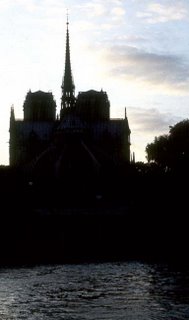 The physical center of Paris is the cathedral of Notre Dame de Paris, the point from which all distances in France are measured. Notre Dame is on the Ile de la Cité, the larger of the two central islands in the Seine River. The Ile Saint Louis is the smaller one. Historically, there were about seven islands. Over time, people filled in the spaces between them creating the two islands we see today.
The physical center of Paris is the cathedral of Notre Dame de Paris, the point from which all distances in France are measured. Notre Dame is on the Ile de la Cité, the larger of the two central islands in the Seine River. The Ile Saint Louis is the smaller one. Historically, there were about seven islands. Over time, people filled in the spaces between them creating the two islands we see today.Start at Notre Dame Cathedral (the closest métro station is Cité, but St.-Michel is just across the river to the south). The building was begun in the 12th Century and is a glorious - though not the most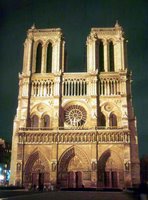 spectacular - example of gothic architecture. For a fee, you can climb the bell towers for impressive views of Paris. On the square (parvis) in front of the cathedral is the entrance to the Crypte du Parvis, an underground archeological exhibit that includes foundations of 2000 year-old buildings on the site. This is the spot where Paris began as a reasonably secure fishing settlement prior to Roman expansion.
spectacular - example of gothic architecture. For a fee, you can climb the bell towers for impressive views of Paris. On the square (parvis) in front of the cathedral is the entrance to the Crypte du Parvis, an underground archeological exhibit that includes foundations of 2000 year-old buildings on the site. This is the spot where Paris began as a reasonably secure fishing settlement prior to Roman expansion.
 spectacular - example of gothic architecture. For a fee, you can climb the bell towers for impressive views of Paris. On the square (parvis) in front of the cathedral is the entrance to the Crypte du Parvis, an underground archeological exhibit that includes foundations of 2000 year-old buildings on the site. This is the spot where Paris began as a reasonably secure fishing settlement prior to Roman expansion.
spectacular - example of gothic architecture. For a fee, you can climb the bell towers for impressive views of Paris. On the square (parvis) in front of the cathedral is the entrance to the Crypte du Parvis, an underground archeological exhibit that includes foundations of 2000 year-old buildings on the site. This is the spot where Paris began as a reasonably secure fishing settlement prior to Roman expansion.From the square, walk west, away from the cathedral (down river) along the Quai du Marché Neuf and the Quai des Orfèvres.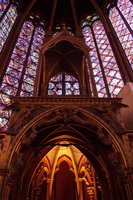 The river will be on your left, and you will pass the Préfecture de Police and the Palais de Justice on your right. Many of the older buildings in these complexes were once the home of the French royal court, but they now serve as the center of Paris’s (and France’s) justice system. Of particular note is the Sainte-Chapelle (right), consecrated in the middle of the 13th Century, a marvelous example of the lightness of gothic architecture.
The river will be on your left, and you will pass the Préfecture de Police and the Palais de Justice on your right. Many of the older buildings in these complexes were once the home of the French royal court, but they now serve as the center of Paris’s (and France’s) justice system. Of particular note is the Sainte-Chapelle (right), consecrated in the middle of the 13th Century, a marvelous example of the lightness of gothic architecture.
 The river will be on your left, and you will pass the Préfecture de Police and the Palais de Justice on your right. Many of the older buildings in these complexes were once the home of the French royal court, but they now serve as the center of Paris’s (and France’s) justice system. Of particular note is the Sainte-Chapelle (right), consecrated in the middle of the 13th Century, a marvelous example of the lightness of gothic architecture.
The river will be on your left, and you will pass the Préfecture de Police and the Palais de Justice on your right. Many of the older buildings in these complexes were once the home of the French royal court, but they now serve as the center of Paris’s (and France’s) justice system. Of particular note is the Sainte-Chapelle (right), consecrated in the middle of the 13th Century, a marvelous example of the lightness of gothic architecture.On the western side of the Palais de Justice, turn right up the rue de Harlay and into the intimate Place Dauphine. The triangular tree-studded place is formed by the Palais on the east and two angled rows of apartment buildings on the north and south. The residential place was developed in the early 17th Century under King Henri IV, whose equestrian statue can be seen just outside the place on the point of the island where the Pont Neuf connects to either bank of the Seine. Exit the place at the tip of the triangle, cross the street to the statue and take the stairs down to the Square du Vert Galant (a nickname for Henri IV), the small tree-shaded park on the island’s tip.
 On the right bank you can see the Samaritaine, until recently one of Paris’s major department stores. It was closed in 2005 for business reasons that remain unclear. The store’s many buildings included a restaurant and a roof-top café that boasted great views from the center of town. The area around the Samaritaine is home to many other large stores, and along the rue de Rivoli just behind, countless shops and boutiques.
On the right bank you can see the Samaritaine, until recently one of Paris’s major department stores. It was closed in 2005 for business reasons that remain unclear. The store’s many buildings included a restaurant and a roof-top café that boasted great views from the center of town. The area around the Samaritaine is home to many other large stores, and along the rue de Rivoli just behind, countless shops and boutiques.Looking down river, you will see the graceful steel arches of the Pont des Arts. In good weather, musicians and artists vie for space along this wonderful pedestrian bridge, which connects the French Institute building (home of the famed Académie Française) and the Louvre (part of which can be seen on the right side of the photo below). Completed in 1804, the Pont des Arts was the first cast-iron bridge to be built in Paris. It was irreparably damaged by a boat and closed in 1970. Fortunately, the bridge was rebuilt, this time in steel but exactly replicating the original, and re-opened in 1984.
Return to the statue of Henri IV, cross the street and make your way to the north side of the island along the Quai de l’Horloge. You will now be headed up-river. On your right is the Conciergerie, part of the Palais de Justice complex that housed prisoners during the French Revolution, including, most famously, Marie Antoinnette.
 The Tour St. Jacques and theaters at Châtelet.
The Tour St. Jacques and theaters at Châtelet. As you continue around the Island, you can stop off at the flower market near the entrance to the Cité subway station. Across the Pont au Change you will see the Châtelet square and theater and the Tour St.-Jacques (above), the only remnant of the church of St.-Jacques-la-Boucherie. Across the Pont d’Arcole you will see Paris’ City Hall, the Hôtel de Ville, a renaissance style building constructed between the 15th and 17th Centuries. In winter, the square in front of the building hosts a public ice skating rink; various other activities, including demonstrations and protests, take place here throughout the year. An interesting fact: the Hôtel de Ville was the inspiration for the New York State Capitol in Albany.
As you continue around the Island, you can stop off at the flower market near the entrance to the Cité subway station. Across the Pont au Change you will see the Châtelet square and theater and the Tour St.-Jacques (above), the only remnant of the church of St.-Jacques-la-Boucherie. Across the Pont d’Arcole you will see Paris’ City Hall, the Hôtel de Ville, a renaissance style building constructed between the 15th and 17th Centuries. In winter, the square in front of the building hosts a public ice skating rink; various other activities, including demonstrations and protests, take place here throughout the year. An interesting fact: the Hôtel de Ville was the inspiration for the New York State Capitol in Albany.Along the Quai aux Fleurs you will have great views of the tip of the Ile St.-Louis. Continue along the river, or duck into the neighborhood on your right. The street that flanks the north side of the cathedral is full of souvenir shops and cafés and is often crowded with visitors. The Square Jean XXIII at the rear of the Notre Dame Cathedral offers great views of the flying buttresses that help support the building. Further east, at the up-river tip of the island, the small Square de l’île de France is home to an underground memorial to the two hundred thousand French Jews deported to Nazi camps during World War II.
neighborhood on your right. The street that flanks the north side of the cathedral is full of souvenir shops and cafés and is often crowded with visitors. The Square Jean XXIII at the rear of the Notre Dame Cathedral offers great views of the flying buttresses that help support the building. Further east, at the up-river tip of the island, the small Square de l’île de France is home to an underground memorial to the two hundred thousand French Jews deported to Nazi camps during World War II.
 neighborhood on your right. The street that flanks the north side of the cathedral is full of souvenir shops and cafés and is often crowded with visitors. The Square Jean XXIII at the rear of the Notre Dame Cathedral offers great views of the flying buttresses that help support the building. Further east, at the up-river tip of the island, the small Square de l’île de France is home to an underground memorial to the two hundred thousand French Jews deported to Nazi camps during World War II.
neighborhood on your right. The street that flanks the north side of the cathedral is full of souvenir shops and cafés and is often crowded with visitors. The Square Jean XXIII at the rear of the Notre Dame Cathedral offers great views of the flying buttresses that help support the building. Further east, at the up-river tip of the island, the small Square de l’île de France is home to an underground memorial to the two hundred thousand French Jews deported to Nazi camps during World War II. Notre Dame's spire at left, Arab Institute in the center, Jussieu on the right.
Notre Dame's spire at left, Arab Institute in the center, Jussieu on the right.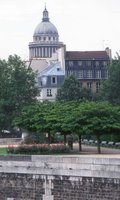 From the square, look across the river toward the Left Bank and you can see the modern glass architecture of the Arab World Institute, founded in 1980. The Institute offers a library, a permanent exhibit of historic Islamic art and often hosts fascinating temporary exhibits. The dome of the Panthéon, while actually on the Left Bank, seems to rise above the square (photo at left, viewed from the Ile St.-Louis).
From the square, look across the river toward the Left Bank and you can see the modern glass architecture of the Arab World Institute, founded in 1980. The Institute offers a library, a permanent exhibit of historic Islamic art and often hosts fascinating temporary exhibits. The dome of the Panthéon, while actually on the Left Bank, seems to rise above the square (photo at left, viewed from the Ile St.-Louis).Exit the square where you entered, turn right and make your way across the Pont St.-Louis, now a pedestrian-only bridge, to the second island. In good weather, the bridge and the square on the Ile St.-Louis are bustling with street performers. Around the square are several restaurants and cafés that fill the sidewalks with outdoor tables – a good lunch spot if you can nab a table. A favorite summer activity here is to stand in line for the delicious ice cream made by the Berthillon company. Enjoy a cone while walking around the island clockwise along the Quai de Bourbon.
Keep an eye out for plaques on the houses commemorating famous architects, owners, or occupants. The Ile St.-Louis was originally developed in the mid 17th Century under King Louis XIII as an exclusive residential quarter for well-to-do businessmen and members of the royal court. Note the rectilinear street pattern on this small island.
 Continue to the Pont de Sully, and then turn back into the island’s main central street,
Continue to the Pont de Sully, and then turn back into the island’s main central street, the rue St.-Louis en l’Ile, seen at right. Along this narrow but straight street you will find the 17th Century church of St.-Louis en l’Ile and many hotels, shops, and restaurants. Once back at the Pont St. Louis, you can return to your starting point on the Ile de la Cité or make your way to either the right or left bank for more walking.
the rue St.-Louis en l’Ile, seen at right. Along this narrow but straight street you will find the 17th Century church of St.-Louis en l’Ile and many hotels, shops, and restaurants. Once back at the Pont St. Louis, you can return to your starting point on the Ile de la Cité or make your way to either the right or left bank for more walking.


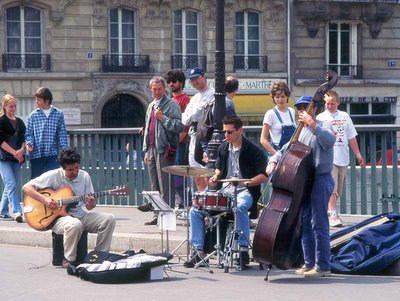






No comments:
Post a Comment
Tell me what you think!